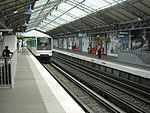Les Olympiades is a district of residential towers located in the 13th arrondissement of Paris, France. Built from 1969 to 1974, the district consists of a dozen towers built along a huge esplanade, elevated eight metres from the ground, that is dedicated to pedestrians. A shopping mall, known as the Pagode, stands at the centre of the esplanade. Below it are streets dedicated to vehicular traffic. Shops and boutiques can easily receive deliveries on the lower level. The main entrances to the residential towers are on the esplanade.
Les Olympiades are designed similarly to the esplanade of La Défense. The Olympiades esplanade has maintained a rather important business and commercial activity, something that is not true of other projects in Paris and its suburbs. The northern part of the neighbourhood is typical of the 13th arrondissement, with the Parc de Choisy and Lycée Claude Monet at the northern edge of the Olympiades and the Place d'Italie three blocks north.
The eight tallest towers are each 104 metres (341 feet) tall and are named after cities that have hosted the Olympic games: Anvers (Antwerp), Athènes (Athens), Cortina, Helsinki, Londres (London), Mexico, Sapporo, and Tokyo. Other residential buildings, which are wider than they are tall, complete the district. The opening in June 2007, of the new Métro station at Les Olympiades, as part of the driverless hi-speed Metro line 14 running every 4 minutes, brought Les Olympiades residents and visitors to the Olympiades complex and its esplanade — shops, restaurants, apartments, and recreational facilities — within 11-14 minutes of Saint-Lazare, Madeleine, and Pyramides on the opposite side of Paris and 2–4 minutes from the new Cour Saint-Émilion entertainment centre and Bibliothèque Nationale François Mitterrand.
Les Olympiades were built with the aspiration that a population of young professionals would be attracted to the complex offering multiple services (education, sports, etc.), a plan known and later criticized as Italie 13. From 1975, its southern end began to attract Vietnamese and Chinese residents, who also populated the main Chinatown in Paris around the southern end of the complex. Since the end of Project Italie 13 the Paris Rive Gauche project began. Starting a few hundred metres from the Olympiades, is the second large-scale urbanism project inside the city of Paris to be built since Italie 13, and they now form a geographic unity with a new influx of professionals and office, education, library, and other complexes, including the François Mitterrand Bibliothèque nationale de France.










